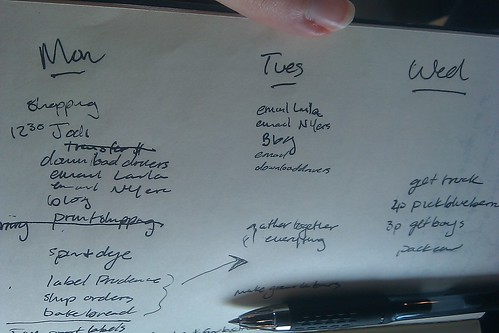Craft shows changed my life.
(I didn't know it until I started writing this post, but as I started to trace the roots of what I do today, I realized that's where it all started.)
Last weekend I sold my yarn for the first time in over a year (I put my yarn business on hold when I could no longer get packages out on time, thanks to traveling to teach. This weekend I was back in the game with a few skeins of my yarn (and my mom's sheep's fiber). Preparing for the show and helping my pal Misty think through the process brought it all back in a rush.
Even though I help Starshippers get prepared for their first shows (and 50th shows) every month, I had forgotten what it was like to be in it.
To be worried you don't have enough.
To do late night, last-minute labeling.
To get nervous about people seeing your work.
So, to calm my nerves, I searched my own site for advice (the major benefit of having a blog!). And sure enough I found it.
In 2008 (that's 6 years ago!), I wrote about my first craft show here, in 5 1/2 Shocking Facts about Craft Shows.
“You don’t have to (and probably can’t) fake enthusiasm.”
A month later, I wrote about my next show, with even more lessons:
“Be prepared to answer the “Can you make this in ***” question. Know how long it would take you and how you’ll handle payment for a custom order. If you don’t want to do custom, come up with a nice way of saying no, so you’re not taken by surprise in the moment.”
One year later, I wrote about the Pain of Craft Shows:
” I do craft shows because it’s the one place, the one situation in which being a full-time yarnie feels good, normal, accepted. The people get me. They get my yarn. It’s a place to be me: handknit clothes, stripey knee-socks, pink-haired, yarn-making me.”
Two years after that first post and my first show, I wrote this: “That feeling hasn’t faded in the last 2 years of doing shows; in fact, it’s only grown stronger.”
It occurred to me, in reading through these posts that this where I really got clear on the power of following my enthusiasm. This is where I learned that it is OK to be weird, pink-haired, wonky me. Those first shows, while I still worked in a boring office in black slacks, were the first taste I had (maybe ever?) of being myself out loud and connecting with people as that true self. Once you get a taste of that, you can start to imagine the possibility of being yourself, expressing yourself, like … all the time.
And this taste, this experience totally transformed my life. (Very, very slowly.)
For me this meant making more yarn, doing more shows, and connecting with people in the maker community. That led to me spending my days writing, talking, and helping other makers bring more of themselves into their businesses, to craft a life they really want.
But for you, the path will be different. It will lead you in different directions. You can start to express yourself more in how you dress, how you tell the truth and how you embrace all your weird bits.
I totally haven't figured it out yet, and I'm certainly not comfortable being myself all the time, but it's a process. You can kick-start the process by choosing to do things you're enthusiastic about, by doing more of what makes you feel like yourself, and by letting those experiences transform you.
Whether it's craft shows, or making your art, or just starting to take your enthusiasm more seriously — it could change your life.
PS. I made a class sharing everything I knew about craft shows 4 years ago. Currently it's only available in the Starship, but I hope to refresh it and offer it again in 2015. Sign up here to get notified when it's ready.





